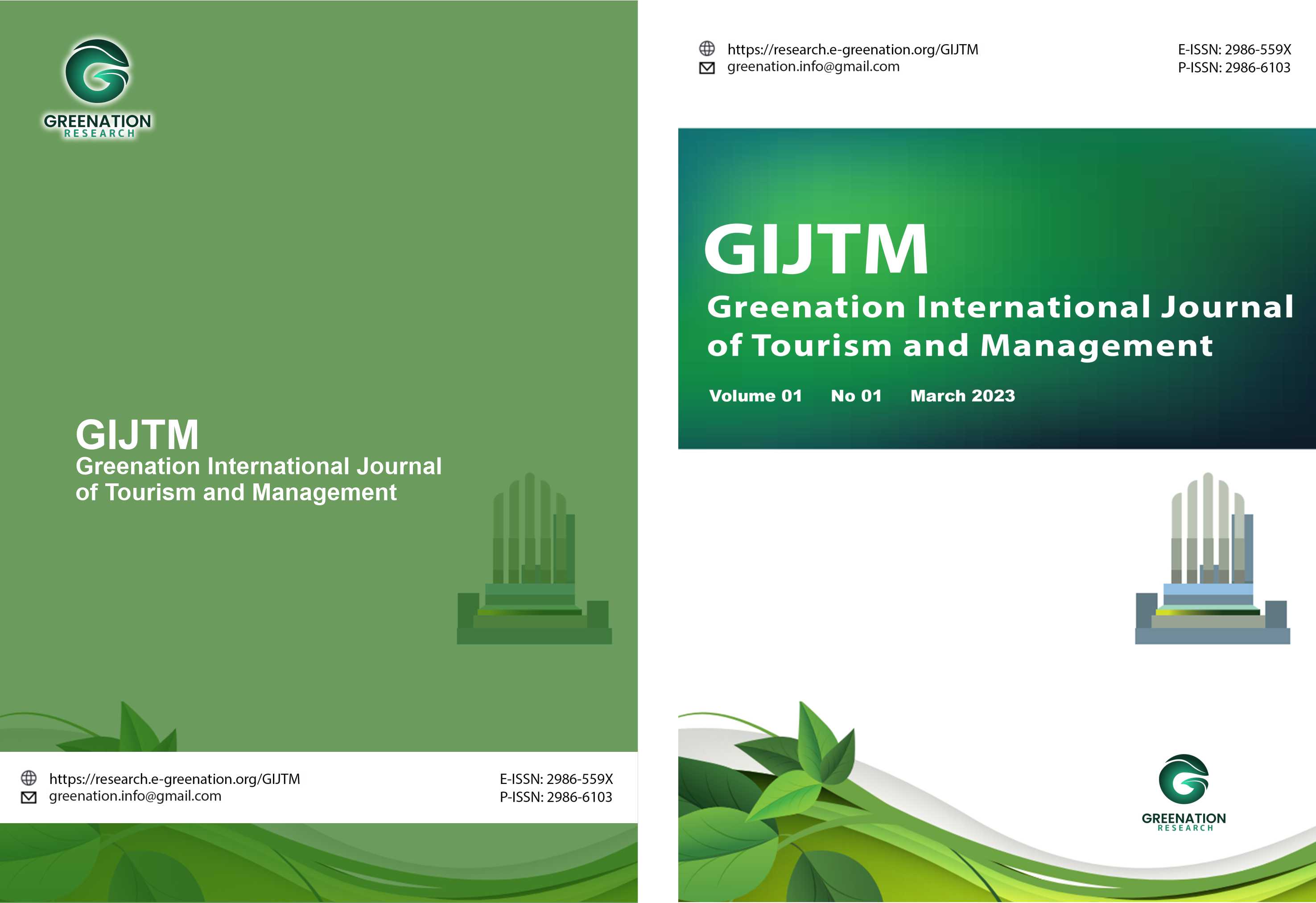Strategy for the Development and Accessibility of Tourist Attractions on Suai Loro Beach, Covalima City, Timor Leste
DOI:
https://doi.org/10.38035/gijtm.v3i2.471Keywords:
Strategy, Development, AccessibilityAbstract
Tourism is a vital non-oil and gas sector for Timor-Leste. This sector is strategic for national economic development. Timor Leste has great potential in tourism, including natural resources, labor, and arts and culture. The tourism sector will provide significant foreign exchange for the country and will create jobs for the community. Suai Loro has great tourism potential, but accessibility to the location is not well developed, making it difficult for tourists and visitors to visit Suai Loro. Therefore, accessibility development is needed to provide good access for tourists and visitors. The purpose of this study is to determine how to develop good accessibility to make it easier for tourists and visitors to visit Suai Loro tourist attractions. This research method is descriptive qualitative,Data collection, Data reduction, Data presentation, Conclusion or verificationThree informants were used: the tribal chief, the community, and visitors. In this study, the researcher also used a SWOT analysis to identify strengths, weaknesses, and advantages. This research was conducted in Suai Loro District, Suai District, Covalina Municipality in 2021. The results concluded that accessibility development is necessary to provide easy access for tourists and visitors, as the area has tourism potential but lacks accessibility.
References
Adisasmita, Rahardjo. (2006). Pembangunan Pedesaan dan Perkotaan. Yogyakarta: Graha Sains.
Antonius Ferry. (2006). Pengaruh Gaya Kepemimpinan Orientasi Tugas dan Orientasi Hubungan terhadap Motivasi Kerja serta Dampaknya terhadap Prestasi Kerja Pegawai Pengadilan Tinggi Tata Usaha Negara Surabaya, Skripsi Universitas 17 Agustus Surabaya.
Bank Dunia. (2017). Pembangunan pariwisata berkelanjutan di Indonesia: tinjauan kebijakan dan program. Jakarta: Kantor Perwakilan Bank Dunia di Indonesia.
Budiati, A. dan Wijayanti, D. (2021). Analisis strategi pengembangan amenitas dan aksesibilitas untuk meningkatkan daya tarik wisata edukasi. Jurnal Pariwisata dan Perhotelan, 10(2), 65–75. https://journal.pubmedia.id/index.php/pjpp/article/view/3327
Cooper, C., Fletcher, J., Fyall, A., Gilbert, D., & Wanhill, S. (2008). Pariwisata: prinsip dan praktik (edisi ke-4). Harlow: Pearson Education.
Damanik, J., dan Weber, HF. (2006). Perencanaan ekowisata: dari teori hingga aplikasi. Yogyakarta: Perpustakaan Mahasiswa.
Darmawan, IGNA dan Wibawa, AP (2019). Aksesibilitas pariwisata dan tantangan pengembangan destinasi di daerah tertinggal. Jurnal Studi Pariwisata, 23(1), 15–27.DOI: 10.24843/JDE.2019.v23.i01.p02
Gamal Suwantoro. (2004). Dasar-Dasar Pariwisata. Yogyakarta: Andi
Gunawan, A. (2020). Perencanaan Destinasi Pariwisata: Teori dan Praktik. Bandung: Alphabet.https://pwk.teknik.untan.ac.id/files/books/planning-destination-tourism.pdf
Inskeep, E. (1991). Perencanaan pariwisata: pendekatan pembangunan terpadu dan berkelanjutan. New York: Van Nostrand Reinhold.
Ismayanti, (2010). Pengantar Pariwisata. Jakarta: PT Gramedia Widisarana Indonesia
Kementerian Pariwisata dan Ekonomi Kreatif Republik Indonesia. (2011). Rencana Induk Pengembangan Pariwisata Nasional (RIPPARNAS) 2010–2025. Jakarta: Kementerian Pariwisata dan Ekonomi Kreatif.
Koesnadi Hardjasoemantri. (2002). Hukum Lingkungan. Yogyakarta: Universitas Gajah Mada Pers.
Oktaviani, RN dan Wibowo, D. (2022). Strategi pengembangan aksesibilitas menuju objek wisata di Kabupaten Kulon Progo. Jurnal Perencanaan Wilayah dan Kota, 15(2), 115–124.
Oktaviani, YA dan Santosa, IW (2022). Strategi Pengembangan Obyek Wisata Alam Berbasis Aksesibilitas di Kawasan Pesisir Selatan. Jurnal Lanskap dan Pariwisata, 5(1), 89–101.https://ejurnal.univbatam.ac.id/index.php/Potensi/article/view/1337
Organisasi Pariwisata Dunia Perserikatan Bangsa-Bangsa (UNWTO). (2013). Pariwisata yang dapat diakses oleh semua orang: sebuah peluang yang dapat kita jangkau. Madrid: UNWTO. https://www.unwto.org/accessible-tourism
Skenario. (2013). Hubungan antara Persepsi Kondisi Fisik Lingkungan Kerja dan Sikap Kerja dalam Meningkatkan Etos Kerja Karyawan UD. ES WE Surakarta. Psikologi Bakat. Vol. II No. 2 (106-116)
Saran. (2011). Metode Penelitian Kuantitatif, Kualitatif dan R&D. Bandung: Afabeta
Setiawan, A. (2020). Strategi pengembangan infrastruktur pariwisata untuk meningkatkan daya saing destinasi. Jurnal Pariwisata Indonesia, 14(1), 32–45.
Siahaan. (2004). NHTEkologi Lingkungan dan Pembangunan. Jakarta: Erlangga.
Sunaryo, B. (2013). Kebijakan pengembangan destinasi pariwisata: konsep dan aplikasi di Indonesia. 2011. ISBN 978-0-333-0 ….
Wahyuni, E. dan Yusuf, M. (2019). Peran aksesibilitas terhadap kepuasan wisatawan di destinasi wisata alam. Jurnal Ilmu Sosial dan Humaniora, 8(3), 154–163.
WTO. (2013). Pedoman pariwisata berkelanjutan untuk pembangunan. Madrid: Organisasi Pariwisata Dunia.
Yoeti, OA (2008). Perencanaan dan Pengembangan Pariwisata. Jakarta: PT.
Downloads
Published
How to Cite
Issue
Section
License
Copyright (c) 2025 Ferdianos Gomes, Arlindo Do Ceu Fatima, Marito Magno, Victor Brito

This work is licensed under a Creative Commons Attribution 4.0 International License.
Copyright :
Authors who publish their manuscripts in this journal agree to the following conditions:
- Copyright in each article belongs to the author.
- The author acknowledges that the Greenation International Journal of Tourism and Management (GIJTM) has the right to be the first to publish under a Creative Commons Attribution 4.0 International license (Attribution 4.0 International CC BY 4.0).
- Authors can submit articles separately, arrange the non-exclusive distribution of manuscripts that have been published in this journal to other versions (for example, sent to the author's institutional repository, publication in a book, etc.), by acknowledging that the manuscript has been published for the first time at GIJTM.


























